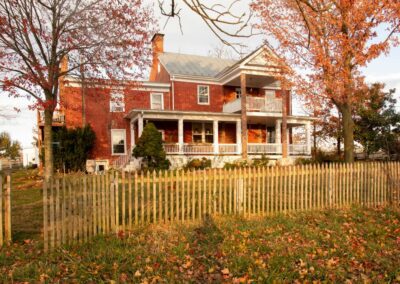Ambient lighting: Lighting in an area from any source that produces general illumination, as opposed to task lighting.
Biodegradeable: A material or substance which will decompose quickly and without harmful effects to the environment, when left exposed to nature.
Building pressurization: The air pressure within a building relative to the air pressure outside. Positive building pressurization is usually desirable to avoid infiltration of unconditioned and unfiltered air. Positive pressurization is maintained by providing adequate outdoor makeup air to the HVAC system to compensate for exhaust and leakage.
Carbon Footprint: A Carbon Footprint is a measure of the impact our activities have on the environment in terms of the amount of greenhouse gases we produce. It is measured in units of carbon dioxide. Here is a carbon footprint calculator from the Nature Conservancy.
Constructed wetland: Any of a variety of designed systems that approximate natural wetlands, use aquatic plants, and can be used to treat wastewater or runoff.
Cradle-to-grave analysis: Analysis of the impact of a product from the beginning of its source gathering processes, through the end of its useful life, to disposal of all waste products. Cradle-to-cradle is a related term signifying the recycling or reuse of materials at the end of their first useful life.
Embodied energy: Embodied Energy is the total energy sequestered from a stock within the earth in order to produce a specific good or service including extraction, manufacture, and transportation to market.
Energy Efficient: Products and systems that use less energy to perform as well or better than standard products. While energy-efficient products sometimes have higher up-front costs, they tend to cost less over their lifetime when the cost of energy consumed is factored in. An example of this is LED light bulbs vs. incandescent bulbs. Here is a good place to start finding Energy Efficient products.
Formaldehyde: A gas used widely in production of adhesives, plastics, preservatives, and fabric treatments and commonly emitted by indoor materials that are made with its compounds. It is highly irritating if inhaled and is now listed as a probable human carcinogen.
Green: A common metaphor referring to environmental association based on the shared secondary color of many plants. It is often used to associate products, organizations, political parties, or policies with environmentally sensitivity. It has largely been misused by marketing departments and therefore has lost true meaning.
Indoor air quality (IAQ): According to ASHRAE Standard 62-1989, indoor air quality is defined as air in which there are no known contaminants at harmful concentrations as determined by cognizant authorities and with which a substantial majority (80 percent or more) of the people exposed do not express dissatisfaction.
LEED/LEED Certification: In the United States and in a number of other countries around the world, the Leadership in Energy and Environmental Design (LEED) certification is the recognized standard for measuring building sustainability. Here is some more in-depth discussion: here.
Life-cycle: The consecutive, interlinked stages of a product, beginning with raw materials acquisition and manufacture and continuing with its fabrication, manufacture, construction, and use, and concluding with any of a variety of recovery, recycling, or waste management options.
Native vegetation: A plant whose presence and survival in a specific region is not due to human intervention.
Natural: A product that is made from materials and ingredients found in nature, with little or no human intervention. For example, wood is a natural material while plastic is not.
Photovoltaic: Generation of electricity from the energy of sunlight, using photocells.
Renewable Energy: Energy derived from sources that do not deplete natural resources. Examples include solar, wind, and geothermal energy from the Earth’s core.
Sustainability: Sustainability is “development that meets the needs of the present without compromising the ability of future generations to meet their own needs.” This definition was created in 1987 at the World Commission on Environment and Development..
Sustainable Design: The design of products, services, buildings, or experiences that are sensitive to environmental issues and achieve greater efficiency and effectiveness in terms of energy and materials
VOC: Organic chemical compounds that have high enough vapor pressures under normal conditions to significantly vaporize and enter the atmosphere. In other words, that new car smell or new paint smell.
Waste Reduction: A process to reduce or eliminate that amount of waste generated at its source or to reduce the amount of toxicity from waste or the reuse of materials. The best way to reduce waste is not to create it in the first place.




